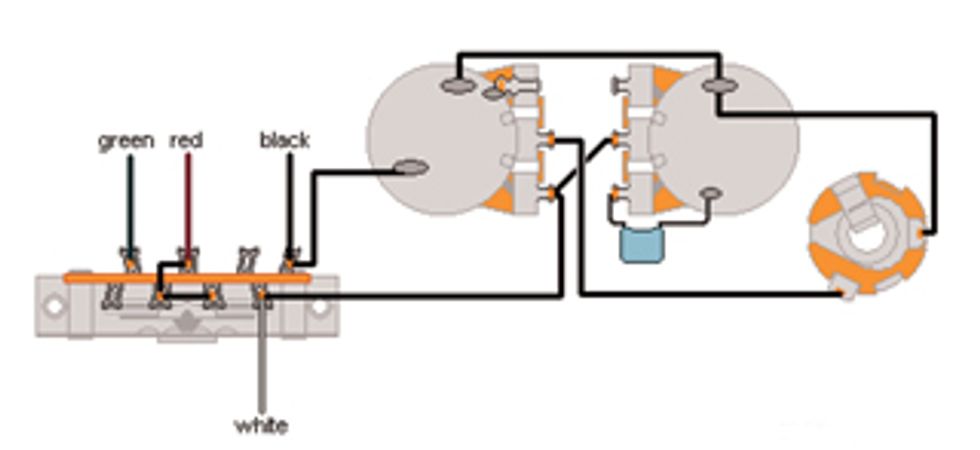Fig. 1. Wiring diagram for 3-way operation of the Chopper T Bridge pickup. Diagram courtesy of dimarzio.com In last month’s column, we began exploring options for installing a humbucker

Fig. 1. Wiring diagram for 3-way operation of the Chopper T Bridge pickup. Diagram courtesy of dimarzio.com
In last month's column, we began exploring options for installing a humbucker pickup in a Fender Esquire. Our first stop was DiMarzio's Chopper T Bridge pickup, and we had so much to discuss about this unit that it required a second installment. (As I mentioned before, I usually don't recommend specific brands or models of pickups, nor do I get paid by any companies for endorsements. I'm making an exception simply because this particular pickup works so well for me and my customers that I want to share this information with you.)
Let's resume where we left off, which is describing the pickup's three modes:
1. Standard humbucking with both coils wired in series. In this mode, the Chopper T offers warm, vintage humbucker tones that are absolutely free of any hum and noise. The sounds are a nice mix of a classic late-'50s Gibson PAF humbucker and a Gibson mini-humbucker, yet there's no doubt you're hearing a Telecaster bridge pickup. The Chopper offers nice attack, bloom, and overtones, but it can get really loud as well and drive your amp into saturation. If I were playing in an oldies or Top 40 band, I wouldn't need any other humbucker tone.
2. Both coils wired in parallel. Still absolutely free of hum and noise but without any humbucker attitude. It sounds like a very good, raw P-90 single-coil pickup— warm and chunky with a good dose of midrange. This mode is ideal for single-coil solos. The Chopper's parallel mode sounds totally different from the full humbucker mode and noticeably different from the third mode.
3. Split mode with one coil shut down. This yields a real Telecaster bridge singlecoil tone with tons of twang, spank, and sparkle—ideal for chicken pickin' and all the other country stuff. I really wish some standard single-coil pickups would sound this good. We've even had customers demand we install this pickup to run permanently as a single-coil in split mode! This is the only pickup I know of that can do this.
So what do you need to set up this wiring? Only a DiMarzio Chopper T Bridge pickup (model DP384). You can reuse your existing two 250k Ω pots and the 3-way pickup selector switch. I've had good experiences using dual 250k pots with this pickup because excessive brightness isn't a problem in this configuration. Another really good combination is a 250k volume pot, plus a 500k tone pot to get the best of both worlds. Two 500k pots sound too bright to my ears, but of course, you can experiment. Some customers are using 300k pots with good results.
Note that the color codes shown in the diagram are only valid for this DiMarzio model. If you use a different pickup, make sure that you use the correct colors at all connections. There are a lot of color transfer charts available on the internet, and for a specific pickup you can also find such information on the manufacturer's webpage.
Besides the four individual wires, there's also a bare wire coming out of the pickup's cable. This one has to be soldered to ground, no matter which ground spot you are using. Be sure the bare wire is not inadvertently touching any other spots.
Ready to install the pickup? Heat up your soldering iron and let's proceed. Here is the switching matrix for the wiring shown in Fig. 1:
Switching position #1. In this rear position, the pickup's two coils are wired in parallel for a fat, hum-free, P-90-like tone.
Switching position #2. In the middle position, one of the two coils is deactivated. This “coil-split mode" yields a real singlecoil sound with all the pros and cons of true single-coil operation.
Switching position #3. In the front position, the pickup's two coils are wired in series, as with standard humbuckers. This mode delivers a full and loud humbucker tone.
In all three switching positions, both controls are always active, so you can use your volume and your tone pot to fine-tune the sound. In addition to trying different potentiometer values, you can experiment with the value and type of tone cap to further customize this wiring—something we've done a lot at the shop. Try a 0.022 μF tone cap—it's a good compromise for all three modes.
Next month, we'll continue exploring the humbucker topic by combining the this column's mods with a flexible wiring scheme. The result provides nine different tones from a single pickup, and we're using this wiring concept in one of our custom Esquire-style models. So stay tuned and keep on modding!
Dirk Wacker lives in
Germany and is fascinated
by anything related to old
Fender guitars and amps.
He plays country, rockabilly,
and surf music in two
bands, works regularly as a
session musician for a local studio, and writes
for several guitar mags. He's also a hardcore
guitar and amp DIY-er who runs an extensive
website—singlecoil.com—on the subject.


